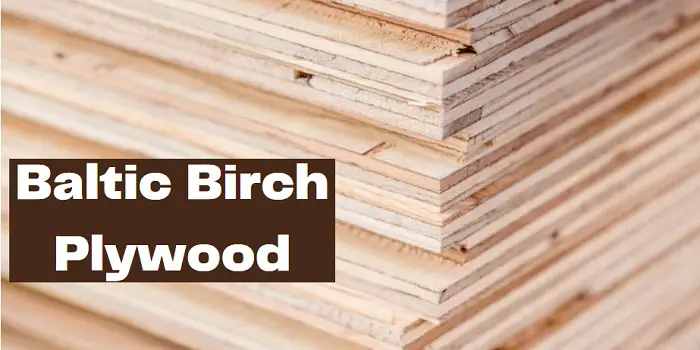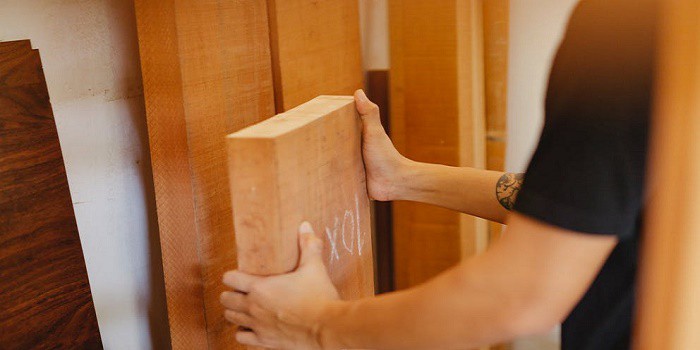
Native to the Northern Hemisphere, the Castanea genus includes around 9 species of chestnut trees, all of which grow nuts consumed by various woodland creatures, birds, and humans.
The chestnuts that grow on these trees are overall similar in nature, but their usage depends on which species the chestnuts are sourced from.
Typically, there are four predominant chestnut species. These include American, Chinese, Japanese, and European.
Chinese chestnut trees are shorter (only about 15 meters in height on average), while European and American chestnut trees are not only taller (averaging about 30 meters) but also grow faster than their Asian brethren.
Characteristics, Properties & Identification
| Scientific Name: | Castanea |
| Tree Height: | 50 to 80 feet tall and 3 to 5 feet in diameter |
| Flowers: | Creamy-white flowers with the strong sweet aroma |
| Wood Type: | Hardwood |
| Workability: | Overall good |
| Grain Pattern: | Straight to spiral or interlocked |
| Color: | Pale white to light or dark brown |
| Odor: | No characteristic smell |
| Texture: | Coarse, uneven texture |
| Durability: | Very durable with good rot resistance |
| Uses: | Home construction, cabinetry, utility poles, railroad ties, flooring, and musical instruments |
Janka Hardness of the Wood
| Sweet Chestnut: | 680 lbf (3,010 N) |
| Horse chestnut: | 820 lbf (3,630 N) |
| American Chestnut: | 540 lbf (2,400 N) |
What is Chestnut Wood Used For?
Chestnut wood has several common, highly suitable uses, including:
1- Flooring
Though not all species of chestnut trees are hardwood, most are suitable for flooring (though not all).
Its strength is less prone to wear, dents, and scratches. However, no chestnut floor is completely resistant to such damage.
To mitigate them, people place area rugs and carpets, pad the legs of furniture pieces and trim pets’ nails.
2- Furniture
To be suitable for crafting rustic furniture, wood should look appealing but also be durable and resistant to damage from shock.
American chestnut is an ideal type of wood for furniture (like coffee tables, kitchen cabinets, etc.) because it is straight-grained, strong, durable, and naturally resistant to rot.
It is also highly conducive to staining. Those looking for a substitute for American chestnut wood often go with oak, as it has many of the same properties.
3- Shingles
Since shingles cover a roof, they should possess several vital attributes, including resistance to water and moss, as well as being strong enough to withstand insect activity and the effects of ultraviolet rays.
Sweet and horse chestnut wood is not very resistant to decay, making American chestnut wood a great choice for shingle design.
In fact, for a long time now, they have been made from that very material, especially in rural areas.
4- Musical Instruments
Designing a great instrument is tough, so it is important to construct them from more pliable wood, as well as one that looks good and contains good adhesive properties.
While mahogany and Sapele are the ideal wood choices for musical instruments, sweet and horse chestnut wood is nearly as good.
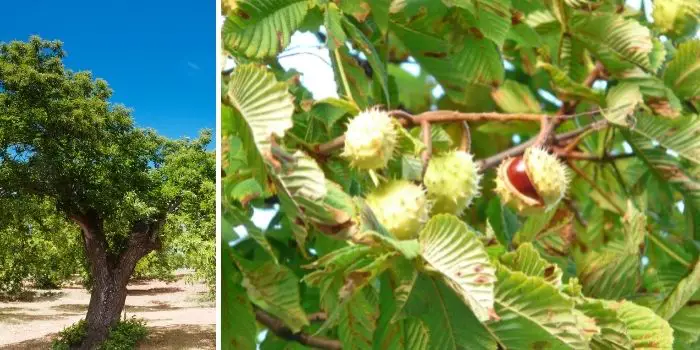
Advantages and Disadvantages of Chestnut Wood
As with anything else, there are advantages and disadvantages to utilizing chestnut wood.
The Pros
a) Versatile:
Several types of chestnut, including American and sweet, are perfect materials for furniture design and fencing.
b) Workability:
Overall chestnut wood is easy to work with both hand and machine tools.
IMO, the workability is much better than other hardwoods because of its low hardness and straight grain.
Compared to the American chestnut, which is many times difficult due to its irregular grain pattern, sweet chestnut is a much better option if you need wood for carving.
However, do note that most species of chestnut will split easily, so you will need to be careful while working on this species.
c) Beautiful appearance:
Chestnut wood comes with a perfect color scheme for the composition of rustic appearances.
These can look great in any exterior or interior setting, helping design anything from living room furniture to farmhouse components.
d) Safe and cost-effective:
There are no significant health risks associated with working with a horse or sweet chestnut wood.
Other types of chestnut wood have been linked to certain allergic skin reactions, something that can be mitigated through a cautious work approach.
While the price of chestnut wood depends on where it is purchased, its grade, and how much of it is purchased, American chestnut can be generally purchased for $15 to $20 per foot.
The Cons
a) Identification:
Many chestnut wood particulates are so similar in appearance and texture that distinguishing them by appearance is challenging even to the trained eye.
This allows many dealers to claim one type of chestnut while selling another. This makes it doubly important that the dealer is reputable.
b) Can split:
Due to the typically straight grain, chestnut wood begins to split after drying, though this is not true for all chestnut species.
One good way to prevent the wood from splitting is to do pre-drilling before you apply any nails or screws to it.
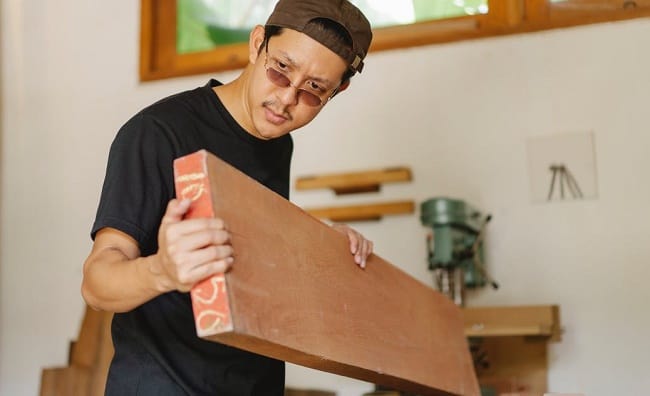
What are the Different Species and Types of Chestnut?
Let’s take a bit of a deeper look at various chestnut trees from around the world.
1- Castanea dentara (American Chestnut)
Native to North America, this beech family member is a large deciduous tree that grows chestnuts most commonly used.
Due to the rapid chestnut harvesting across the 20th century, many American chestnut trees were cut down, causing a rapid population decline in the formerly prosperous species.
American chestnut is a particularly durable type of wood, especially due to its resistance to rot.
While its Janka hardness is average (540 lbf or 2400 N), thanks to its durability, this type of chestnut wood is used for shingles, floors, and crafting of rustic furniture.
Throughout its life, the heartwood tends to be a light to a medium shade of brown, though after it ages, it takes on a reddish-brown hue.
Sapwood, on the other hand, is white or light brown in color. However, these are not steadfast rules either. Insect presence in the wood influences the color as well.
It possesses interlocked or spiral grain.
While the texture of American Chestnut wood is coarse and uneven, this type of wood is conducive to applying for workable purposes, being the optimal wood choice for most stains, adhesives, and finishes.
2- Castanea sativa (Sweet Chestnut)
These long-lasting chestnut tree species (lasting between 4 and 4.5 centuries) from the Fagaceae family are often referred to as European or Spanish chestnut trees.
Sweet chestnut trees are generally found across Southern Europe, as well as areas of Asia Minor.
The heartwood is typically light/medium shades of brown, turning more reddish-brown with age, while the sapwood is generally a pale white or light brown in color.
The tree’s seeds are also its nuts. They are very popular in the global market.
Due to its hardness and strength, sweet chestnut wood is commonly used for furniture and veneer building, as well as for crafting little wooden objects, thanks to the ease with which it can be molded and carved.
Work fantastically with various tools from both machines and of the hand-use variety.
Because this type of wood splits easily, it’s more suitable for being pre-screwed instead of drilling screws directly into it or using nails.
The texture is coarse and uneven, with an interlocked or spiraled grain.
3- Castanea Crenata (Japanese Chestnut)
This small to medium-sized deciduous tree is native to Japan and Korea and is actually sometimes referred to as Korean chestnut.
It has a tree structure and leaves similar to sweet chestnut but grows shorter (only about 10 to 15 feet in height).
It grows both male and female flowers which can be easily recognized, with the male ones growing high up on the tree while the female ones growing lower.
Its nuts are heavily cultivated and featured in Japan.
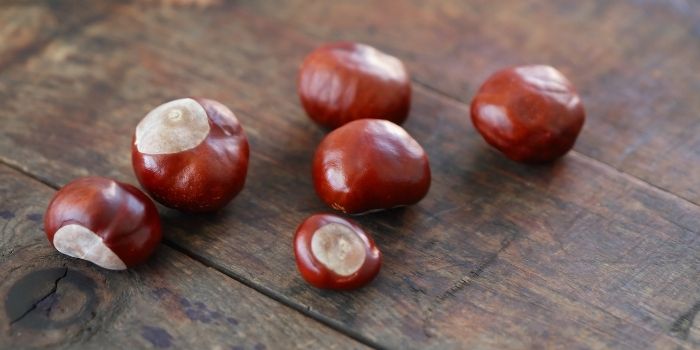
4- Castanea Mollissima (Chinese Chestnut)
This deciduous species is native to China, Korea, and Taiwan. It typically grows 10 meters wide and 20 meters tall, with wide leaves.
These trees experience an average annual growth of 1 to 2 feet.
The nuts produced by these trees are widely cultivated by East Asian farmers and are in high demand on the market.
Unlike some other chestnut tree species, the Chinese chestnut has a uniform texture with a grain pattern that is straight.
Chinese chestnut wood is great for workability with tools and is highly durable, as well as rot-resistant. This makes the material great for furniture and construction purposes, though it does split easily.
5- Castanea Pumila (Dwarf Chestnut)
Found in the dry and rocky southeastern regions of the US, the Dwarf Chestnut, sometimes known as Allegheny chinquapin, is the shortest chestnut species in the world, growing only from 2 to 8 meters in height.
This chestnut tree is vastly cultivated for its nuts which are a great source of nourishment for woodland creatures, including squirrels and rabbits.
The heartwood of the wood is yellowish-brown in color, while the sapwood most closely resembles white.
The wood is known for its interlocked and straight pattern to this chestnut wood’s grain. It is easy to work with, glue, finish and apply machine tools to.
Mostly it is used for crafting furniture and fencing thanks to its durability. Also, it makes great firewood.
6- Aesculus Hippocastanum (Horse Chestnut)
While its name implies otherwise, these are not generally regarded as true chestnut trees, though they do produce nuts that are similar enough to other chestnut species.
Regardless, this wood is known for its strength and durability, making it a fine choice for the construction of various wooden products.
Unlike other chestnut varieties, the Horse chestnut wood does not contain rot-resistant properties, which limits its functionality to really only perform well in crafting indoor objects such as furniture, veneer, interior trim, broom handles, racket grips, boxes, kitchen utensils, toys, etc.
The heartwood of this wood is yellowish-brown or creamy-white in appearance, while the sapwood is white.
This tree’s wood allows furniture designed from it to have a uniform texture, though the grain is interlocked.
This pattern type makes the material somewhat challenging to work with, but in general, it works well with finishes and adhesives.
7- Castanea Seguinii (Seguin Chestnut)
This is a small tree or a shrub, sometimes known as Chinese chinquapin, and is native to the southeastern and south-central regions of China.
Because the nuts it produces are small, they are not commercially sold, but it is harvested and cultivated by the area’s locals for personal consumption.
FAQs
What is wormy chestnut?
Wormy chestnut is a kind of wood that is insect-damaged.
It’s usually lumber from the American chestnut tree, which was mostly damaged by the timber borer beetle that laid its eggs in the bark of the chestnut tree.
This damage was typically in the form of discoloration and holes in the tree wood, which was then harvested and converted into lumber for use.
Since the parent tree is now very rare, wormy chestnut still holds a great demand in the market and is usually derived from old structures.
Are nuts from chestnut trees poisonous?
While chestnut trees start producing the nuts when it’s about 3-5 years old, not all species of chestnut nuts are edible in nature.
American, European, Chinese, and Japanese are mostly edible, whereas horse chestnuts are toxic and shouldn’t be eaten.
To many, these can cause digestive disorders such as abdominal pain, nausea, vomiting, or throat irritation.
Fortunately, you can know if a chestnut is edible by looking at the casing, where the chestnut is wrapped when hanging on the tree.
If it’s edible, it will most likely have a shiny brown color, a flat bottom, and a point on the top.
Chestnut wood vs. oak: which is the better option?
American Chestnut trees and their lumber is both very rare, making them relatively valuable.
That’s also the reason why chestnut wood is presently salvaged (from old barns and other structures) in huge quantities, which is then reprocessed and sold as reclaimed lumber.
Oak, on the other hand, is common lumber for furniture due to its easy availability on the lumber market.
Both types of wood are beautiful and will hold their value for years to come. It all comes down to availability and the price you may need to pay to get them.
Final Thoughts
As recently as a century ago, 25% of forests in the Northern Hemisphere consisted of chestnut wood, but the population has dramatically declined since then.
Chestnut planting is ramping up thanks to multiple organizations that aim to save the species, mostly since over-forestation has all but driven American chestnut trees out of existence.
However, due to its many positive attributes, chestnut wood commands a higher price on the market. But when bought in bulk, some dealers offer a bulk discount.

Hi, I am Mark Garner a professional carpenter, woodworker, and DIY painter. I live in the small city of Peoria, Arizona as a semi-retired woodworker. I have started this blog with a simple motive to help you with my wood experience in this sector. If you like to know more about what I love doing and how it all got started, you can check more about me here.




